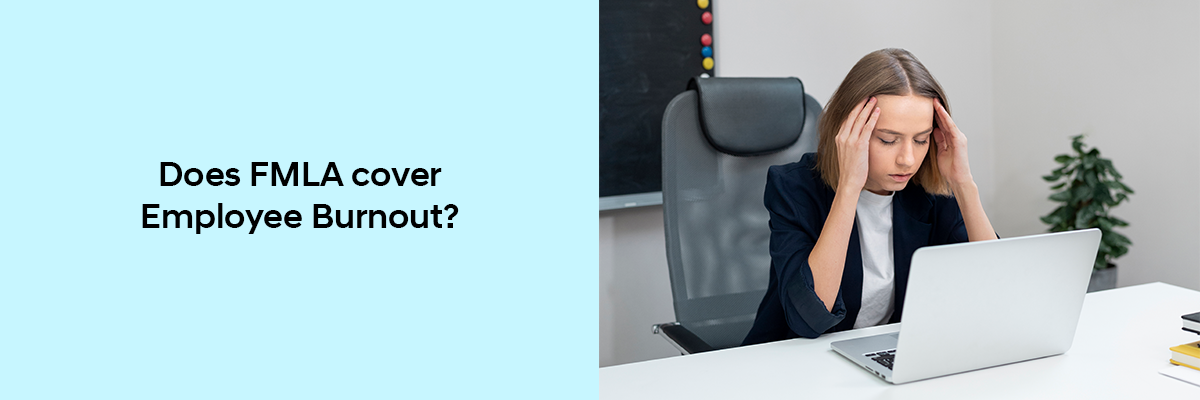In today’s fast-paced work environment, employee burnout is no longer just a buzzword, it’s a genuine concern for employers and employees alike. Long hours, tight deadlines, and increased responsibilities can all contribute to emotional exhaustion, reduced productivity, and even physical symptoms. But when burnout becomes severe, can employees take time off under the Family and Medical Leave Act (FMLA)? And what additional protections exist for employees in California?
Let’s dive into how the law views burnout and when it might qualify for protected leave.



What Is Employee Burnout?
Burnout is a state of chronic physical and emotional exhaustion caused by prolonged stress. According to the World Health Organization (WHO), burnout is an occupational phenomenon characterized by:
- Feelings of energy depletion or exhaustion
- Increased mental distance from one’s job, or feelings of negativism or cynicism
- Reduced professional efficacy
Burnout can manifest in serious ways, depression, anxiety, insomnia, and even physical health conditions. But does this make it a “serious health condition” under FMLA?
FMLA and Mental Health: Is Burnout Covered?
Under the FMLA, eligible employees can take up to 12 weeks of unpaid, job-protected leave per year for specific reasons, including a serious health condition that makes the employee unable to perform the essential functions of their job.
While “burnout” itself isn’t explicitly listed under FMLA, the symptoms of burnout, if they meet the criteria of a serious health condition, may be covered. For example:
Burnout may be covered if it results in:
- A diagnosis of depression, anxiety, or another mental health disorder
- Ongoing treatment by a healthcare provider
- Inpatient care or continuing treatment
If an employee sees a doctor and is diagnosed with a mental health condition caused by or resulting in burnout, they may qualify for FMLA leave. However, the key is medical certification. Employers have the right to request documentation verifying the serious health condition. Read this guide to FMLA compliance for employers.
Documentation and Employer Obligations
Employees seeking FMLA leave due to burnout-related issues must:
- Be eligible (worked at least 12 months and 1,250 hours in the past year)
- Work for a covered employer (generally those with 50 or more employees within 75 miles)
- Provide a healthcare provider’s certification
Employers must treat this request like any other FMLA claim and cannot retaliate against the employee for taking protected leave.
California-Specific Protections for Burnout
California offers even broader protections than federal FMLA. Here’s how:
1. California Family Rights Act (CFRA)
The CFRA mirrors many provisions of FMLA but applies to more employers (those with 5+ employees) and offers 12 weeks of job-protected leave for serious health conditions, including mental health disorders.
Notably:
- CFRA does not require a diagnosis to align with a specific federal definition of serious health condition.
- It recognizes mental health conditions such as anxiety, depression, and stress-related illnesses as valid reasons for leave.
So, in California, even if your burnout isn’t covered under FMLA, it may qualify under CFRA if it rises to the level of a serious health condition.
2. Paid Sick Leave and Supplemental Leave
California mandates paid sick leave, which can be used for stress-related medical appointments or short-term rest. Some local jurisdictions offer even more generous leave entitlements.
3. State Disability Insurance (SDI)
If an employee is temporarily unable to work due to burnout that has been medically certified as a disability (e.g., depression, severe anxiety), they may qualify for California State Disability Insurance (SDI) benefits while on leave.
4. Reasonable Accommodation under FEHA
Under the Fair Employment and Housing Act (FEHA), employers must provide reasonable accommodations for employees with mental health disabilities, including modified work schedules or temporary leave.
When Burnout Isn’t Covered
There are cases where burnout may not qualify for leave under FMLA or CFRA:
- If no formal medical diagnosis is provided
- If burnout is short-term and does not impair work functions
- If the employer is not covered by FMLA or CFRA
However, even in these cases, open communication and workplace accommodations can be explored to support the employee.
Best Practices for Employers
To stay compliant and support employee well-being:
- Train HR staff and managers on how to recognize and respond to burnout-related leave requests.
- Maintain clear policies on FMLA/CFRA leave and reasonable accommodations.
- Respect confidentiality and handle medical documentation sensitively.
- Encourage mental health support through Employee Assistance Programs (EAPs).
- Stay updated on state-specific requirements, especially in California where protections are more robust.
We provide in-depth webinars and training materials to help HR professionals and organizations stay ahead of evolving workplace laws, including FMLA, CFRA, and mental health compliance. Explore our upcoming training sessions for custom workplace compliance solutions.
Final Thoughts
While the term “burnout” might not appear in FMLA regulations, its underlying causes, especially when medically documented, can absolutely qualify for leave under both FMLA and CFRA. Employees in California benefit from additional protections that ensure their mental health is taken as seriously as physical health.
In an era where emotional well-being is crucial to workplace success, it’s essential for employers to treat burnout not just as a productivity issue, but as a legitimate health concern deserving legal protection and compassionate response.
If you found this blog valuable and informative, and you’d like to explore HR topics in more depth, directly from experienced HR professionals, be sure to check out our human resources webinars


